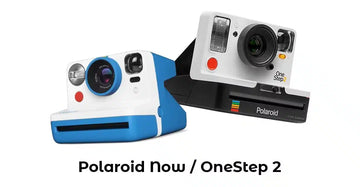How to Safely Remove and Replace Polaroid Film Without Wasting a Single Shot
przez Дашка Шипунова na Jul 29, 2025

Preserving Your Polaroid Memories: A Step-by-Step Guide
As an avid Polaroid photographer, I know the frustration of wanting to swap out film but dreading the potential waste of precious, irreplaceable shots. Whether you're transitioning from color to black and white film or simply want to reload your camera, the process of removing a partially used film pack can be daunting. But fear not, my fellow analog enthusiasts - I'm here to share a foolproof method that will allow you to change your Polaroid film without sacrificing a single exposure.
In this comprehensive guide, I'll walk you through the simple steps to safely remove a Polaroid film pack, protect your existing images, and seamlessly reload your camera with a new film type. By the end, you'll be a pro at film swapping, able to preserve your Polaroid memories with confidence. So, let's dive in and unlock the secrets to mastering this essential Polaroid technique!
Preparing for a Successful Film Swap
Before we get started, it's important to ensure you have the right tools on hand. The key item you'll need is the Polaroid dark slide that comes packaged with each film pack. This unassuming piece of cardboard is the key to protecting your existing exposures during the film removal process.
Additionally, you'll want to work in a dimly lit environment, such as a bathroom or closet, to minimize the risk of light leaks. Polaroid film is incredibly sensitive to light, so taking these precautions will help safeguard your precious images.
Step 1: Inserting the Dark Slide
With your Polaroid camera loaded with a partially used film pack, gently slide the dark slide into the film compartment, positioning it directly on top of the first unexposed frame. This creates a light-tight barrier, shielding the sensitive film from any accidental exposure.
Be extremely careful during this step - it's crucial that the dark slide is placed on top of the film, not underneath. If you accidentally insert it beneath the first frame, you'll risk ruining the entire film pack when you remove it from the camera.
Step 2: Removing the Film Pack
Once the dark slide is securely in place, you can safely remove the film pack from the camera. Gently pull the pack out, keeping the dark slide positioned on top of the first frame. This will ensure that no light reaches the film and ruins your existing exposures.
If you're working in a dimly lit environment, you can take an extra precaution by starting the film removal process in the light and then finishing it in the dark. Simply insert the dark slide as far as it will go, then move to a completely dark room to fully extract the film pack.
Step 3: Storing the Film Pack
With the film pack now safely removed from the camera, it's time to store it properly. If you plan to use the remaining exposures in the near future, you can keep the pack in a light-tight container, such as a camera bag or box, to protect it from any stray light.
However, if you're swapping in a new film type, such as transitioning from color to black and white, you'll want to take an extra step to ensure the film's longevity. Carefully slide the dark slide all the way down, covering the entire film pack, and then store it in a completely dark environment until you're ready to use it again.
Step 4: Reloading the Camera
Now that you've safely removed the film pack, it's time to load your camera with a new one. Start by ensuring that the film compartment is completely clear of any debris or obstructions. Then, gently insert the new film pack, making sure it clicks into place securely.
If you encounter any resistance or the film pack doesn't seem to be seating properly, don't force it. Instead, double-check the compartment and try again. Forcing the film pack could potentially damage your camera or the film itself, so it's better to take your time and ensure a proper fit.
Troubleshooting Common Film Swap Issues
While the process of removing and replacing Polaroid film is relatively straightforward, there are a few potential hiccups you may encounter along the way. Here are some common issues and how to address them:
The Camera Doesn't Eject the Film Pack
If your Polaroid camera doesn't automatically eject the film pack when you open the compartment, don't panic. This could be due to a variety of reasons, such as a stuck mechanism or a film pack that's not fully inserted.
- First, try gently pushing the film pack back in, ensuring it's seated properly. Then, close the compartment and see if the camera will eject it on its own.
- If that doesn't work, you can try manually ejecting the film pack. Consult your camera's user manual for specific instructions, as the process may vary depending on the model.
- As a last resort, you can carefully remove the film pack by hand, using the dark slide to protect the existing exposures. Just be extremely cautious during this process to avoid any light leaks.
The Dark Slide Gets Stuck
Sometimes, the dark slide can become stuck or difficult to remove, especially if it's been in the film pack for a while. This can be a frustrating situation, but there are a few things you can try:
- Gently wiggle and pull the dark slide, being careful not to force it. The goal is to coax it out without damaging the film pack.
- If the slide is still stuck, try using a pair of tweezers or small pliers to carefully grip and extract it. Apply gentle pressure and avoid pulling too hard.
- As a last resort, you can try using a small, blunt tool, such as a toothpick or paperclip, to carefully dislodge the dark slide. Just be extremely cautious to avoid scratching or puncturing the film.
The Film Pack Doesn't Fit Properly
If you're having trouble getting a new film pack to fit snugly in your Polaroid camera, there are a few things you can check:
- Ensure that the film compartment is free of any debris or obstructions that could be preventing a proper fit.
- Double-check that you're using the correct film type for your camera model. Polaroid film packs are designed to work with specific camera models, so using the wrong one could cause compatibility issues.
- If the film pack still doesn't seem to be seating correctly, consult your camera's user manual or reach out to the manufacturer for further guidance. They may be able to provide troubleshooting tips or recommend a solution.
Maximizing Your Polaroid Film Usage
Now that you've mastered the art of safely removing and replacing Polaroid film, it's time to explore ways to get the most out of your film packs. Here are a few tips to help you maximize your Polaroid film usage:
Experiment with Different Film Types
One of the joys of Polaroid photography is the ability to experiment with a wide range of film types, each with its own unique characteristics. Whether you're drawn to the vibrant colors of Polaroid 600 film, the moody tones of black and white, or the dreamy effects of Polaroid's specialty films, swapping out your film can breathe new life into your creative process.
By following the steps outlined in this guide, you can easily transition between film types without wasting a single exposure. This allows you to explore the full breadth of Polaroid's offerings and find the perfect medium to capture your vision.
Reuse Partially Exposed Film Packs
Another way to maximize your Polaroid film usage is to reuse partially exposed film packs. If you have a pack with a few remaining exposures, you can safely remove it from your camera and store it for later use, as long as you follow the proper steps to protect the existing images.
This can be especially useful if you're working on a long-term project or want to experiment with different techniques across multiple film packs. Just be sure to store the partially used packs in a light-tight container to prevent any accidental exposure.
Embrace the Unpredictable
One of the most captivating aspects of Polaroid photography is the element of surprise. With each exposure, you never quite know what the final result will be - the unique characteristics of the film, the lighting conditions, and even the way you handle the camera can all contribute to the final image.
By embracing this unpredictability and experimenting with different techniques, you can unlock a world of creative possibilities. Don't be afraid to try new things, whether it's double exposures, light leaks, or unconventional framing. The beauty of Polaroid lies in the unexpected, so let your creativity flow and see what unexpected wonders you can capture.
Conclusion: Preserving Your Polaroid Memories with Confidence
Mastering the art of safely removing and replacing Polaroid film is a game-changer for any analog photographer. By following the steps outlined in this guide, you can confidently swap out film packs without wasting a single precious exposure, allowing you to explore the full creative potential of your Polaroid camera.
Remember, the key to success lies in the dark slide - use it diligently to protect your existing images, and you'll be well on your way to preserving a lifetime of Polaroid memories. So, go forth, my fellow Polaroid enthusiasts, and let your creativity shine through with every click of the shutter!




